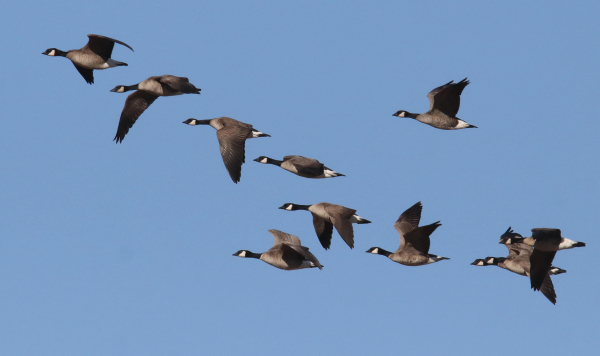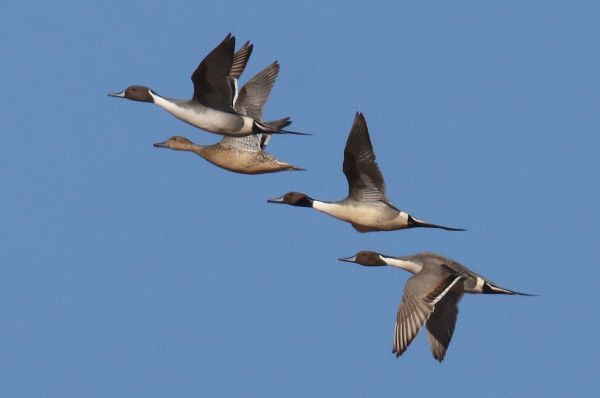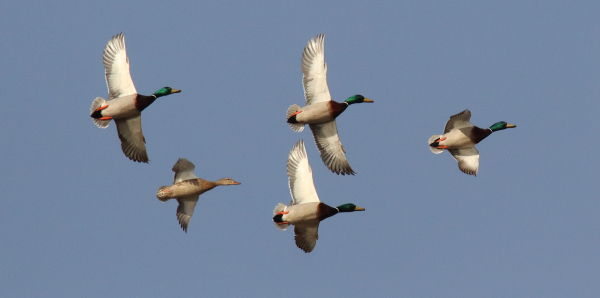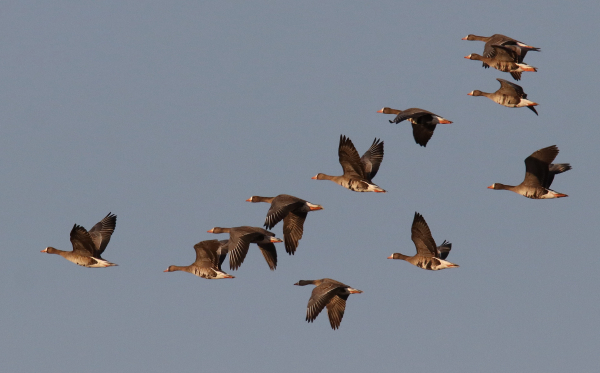The dam broke at last, with 5 species of geese flocking north across the border, mostly Thursday through Saturday. Before that, with no true birding plan Wednesday I felt the need to drive to the border that divides the Dakotas, then southeast, just in case waterfowl and raptors were concentrated up to edge of northern South Dakota. Until I was 35 miles south, it was a relatively birdless day, and then only a single Red-tailed Hawk showed up. But the true test would be a few miles east, along the open water of the James River, where it spreads across a floodplain at Sand Lake National Wildlife Refuge.

It’s always a treat when the small Arctic-nesting Cackling Geese arrive, the last of 5 species of geese to migrate into the area this spring (600mm zoom lens, f-10 aperture, 1/2500 shutter speed, 800 ISO).
There was still plenty of ice on the big open lake areas, but along the main river course and some associated marshlands, open water was present, and so were thousands of waterfowl! There were literally 2 huge clouds of Snow Geese with a percentage of Ross’s Geese mixed. Separate from the Snows were 2 expansive flocks of White-fronted Geese with many Cackling Geese mixed in, along with some much larger Canada Geese. This was as far as this vanguard of geese would go Wednesday it appeared, and it was exciting to see and hear the variety of calls as I moved from flock to flock.
The real excitement happened when a Bald Eagle approached 1 of the flocks, with the air erupting with the roar of goose wings taking flight and forming a real curtain of Snows that created a stadium-like sound of thousands of geese calling in alarm all at once. The eagles calmly winged by, watching for any potential flightless birds, and after they passed, the geese immediately began circling back to their place on the ice or open water, creating another curtain of birds as they were landing. In total, I counted 17 Bald Eagles, with 11 standing on the ice near the goose stadium, mostly feeding on dead fish that were being exposed as the ice melted around them.

As the afternoon sunlight began to fade, I wanted to keep as broad an area in focus as possible to keep as many Redheads in sharp focus as possible, so using the f-10 aperture, the shutter speed was fast enough to stop the motion of the displaying male in the center of the photo frame (600mm zoom lens, f-10 aperture, 1/800 shutter speed, 800 ISO).
The first ducks of spring were widely scattered in open water areas, with Mallards far outnumbering all others by hundreds. Northern Pintails were obviously the next most common ducks, but there were 11 species scattered in small numbers, some with only limited representation, such as a single Bufflehead, 2 Redheads, 2 Hooded Mergansers, and 3 Northern Shovelers. There were a few pairs of American Wigeons, male Common Goldeneyes, Ring-necked Ducks, Common Mergansers, Green-winged Teal – and that’s 11 species total – not bad.

A pleasing view of Northern Pintails in flight was a favorite, and it’s indicative of a mating flight between a female and 3 males. Mating flights are always difficult to photograph because the ducks cover a lot of airspace above a marsh quickly (600mm zoom lens, f-10 aperture, 1/3200 shutter speed, 800 ISO).
In addition, there were my first South Dakota sightings of a Killdeer, a Western Meadowlark, American Robins, Red-winged Blackbirds, and Ring-billed Gulls. Add a few cocky Ring-necked Pheasants and I’d call it a great assemblage of birds at the apex of the limit of the northern migration of birds along the eastern side of the Great Plains. It was an exciting breakthrough to meet the birds head-on even before they broke through the border to my home state – North Dakota – as early as the next day.
As for photographing birds as I made my way along the edges of the refuge, I was thrilled to have such an active photo session. In fact, I extended my stay at Sand Lake Refuge by almost 2 hours to wait for the geese to fly out to feed in surrounding harvested cornfields. In the meantime, I spent some time trying to photograph some male Common Goldeneyes, and to document the mating activities of some ducks. One especially surprising group of Mallards numbered 20 colorful green-headed males courting a single female. She didn’t look all that impressive from a distance, but that must have been the biggest courting party I’ve witnessed, so I tried my best to document the group. It took some patience, and I returned to the location 3 times, surprised to see the group stayed in much the same area during the hour or so I monitored their movements. Finally, the little lady took the males for a ride, or at least a spirited flight, with the drakes following her every move as she swayed up and down, circled and glided, then turned again. The flight segment of the photo effort was even harder to document, but it was fun to try to get some photos nonetheless.

Taking advantage of a moment when the iridescent green plumage on the head of most of these 16 male Mallards was highlighted by waning sunlight, this documentary photo shows what must be an amazing female to attract such an attentive group of potential mates, which numbered 20 drakes at times (600mm zoom lens, f-10 aperture, 1/1000 shutter speed, 800 ISO).
The display flight ended when the female directed the group of males into a pool surrounded by cattails, out of sight. But there were other mating flights ongoing too, with 4 or 5 males trying to interest a female; and there were many pairs that had already established spring bonds. The first feeding action seemed eminent as hundreds of geese began rising up from the rivercourse with flocks peeling off, heading west and east. I repositioned a couple times to try to get into the flight track of flocks with the sun at my back, especially keying in on flocks of White-fronted Geese and Snows. The evening feeding flight is always an exciting activity to witness, and considering that it was essentially the first big flight I was witnessing this spring, I enjoyed it all the more.

Another female Mallard is escorted by a foursome of males in a mating flight, even while still in migration mode (600mm zoom lens, f-8 aperture, 1/2500 shutter speed, 800 ISO).
There is something about photographing geese in flocks and trying to get images of birds in just the right positions, or with representative spacing that is exciting as you follow the movements of the flocks and the progression of the geese in transit. Eventually, the flocks began to concentrate and started to swirl in a giant circle until they found what must have been just the right place to begin landing to feed. First by the tens, then by the hundreds, geese approached a landing spot to put on their winged brakes, drop their webbed feet, and touchdown, barely catching their breath before bending their head forward to begin selecting kernels of corn scattered across the ground. I never tire of witnessing the process and being in position to photograph the 5 species of geese engaged in the variety ways they act and react during feeding missions, and during all aspects of their migrations.
Wednesday night, Thursday, Thursday night, and Friday all had periods of significant migration periods in my area toward the northwest, which included the first Cackling Geese, Ring-billed Gulls, Western Meadowlarks, and Red-winged Blackbirds of the season, with thousands more geese passing through before the dramatic change in weather during mid-afternoon Friday. That’s when 65 degree temperature with almost calm conditions switched to a 30mph north wind that dictated a halt to migration’s northward progress. I’ll end this first account of the regional migration progress here, but you can refer to more accounts and photographs that I took closer to home during the first week of waterfowl migration in my Editor Afield article in this issue.

With pre-sunset light adding an extra glow to these White-fronted Geese on their way to a feeding field, the f-8 aperture provided an adequately wide area in focus to include all the northbound geese (600mm zoom lens, f-8 aperture, 1/2000 shutter speed, 800 ISO).
There will be many more exciting migration days to come, but chronicling the first big push of birds north was very special and it brings back lots of memories of being in the field in the chill air with my camera with goose music surrounding me. I hope you have been enjoying some early spring birding activities with your camera, and hope the first day of spring (tomorrow) is a turning point as we enjoy exciting migration periods yet to come. Good Luck!
Article and Photographs by Paul Konrad
Share your bird photos and birding experiences at editorstbw2@gmail.com